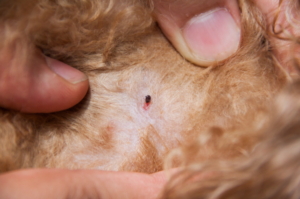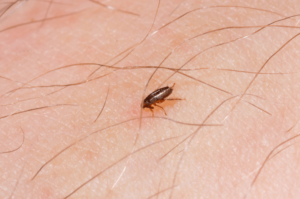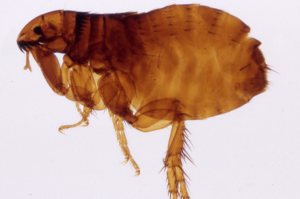Everything You Need to Know About Fleas

Caring about your pets and family means taking preventative measures to protect them from fleas throughout the year.
Fleas are very common throughout Wisconsin but can be managed with the proper care and precautions.
What Are Fleas?
Fleas are small, wingless insects that are parasitic on warm-blooded animals, commonly feeding on the blood of mammals and birds.
Fleas can also jump long distances — up to 7 inches vertically and about 13 inches horizontally — to help them move quickly between hosts.
Are Fleas Harmful to Pets?

Fleas can cause irritation, itching, and discomfort to dogs, cats, and other pets, and potentially transmit deadly diseases if not properly treated.
Flea infestations in pets can cause allergic reactions, skin infections, and anemia (due to blood loss from flea feeding), especially in young or small animals. As cats, dogs, and other pets groom themselves, they can also ingest fleas, leading to the development of tapeworm infections.
It’s important to take preventative measures to control flea infestations in both your home and pets. Use flea treatments for pets as recommended by your vet, including chewable tablets, flea shampoo, and flea collars, in addition to regularly grooming and inspecting your pets for fleas.
These preventatives will help prevent issues with both fleas and ticks throughout the warmer Wisconsin weather.
Are Fleas Fleas Harmful to Humans?

Flea bites are more of a nuisance for humans, but may cause itching, irritation, and discomfort.
These bites can cause allergic reactions in some individuals, leading to more severe itching and skin irritation. In more severe cases, fleas can transmit diseases such as typhus, bubonic plague, and bartonellosis (cat scratch fever) to humans.
Although these diseases are rare, it’s important to take precautions, such as spraying for fleas with the help of pest control professionals, to ensure you stay safe and healthy.
What Do Fleas Look Like?

Fleas have small, reddish-brown flattened bodies that are 1 to 4 millimeters in length as adults and covered in bristly hair, allowing them to move easily through the fur or feathers of their host.
They have six legs, with the hind legs well-developed for jumping.
Fleas have specialized mouthparts adapted for piercing the skin of their hosts and sucking blood.
What is a Flea’s Life Span?
A flea’s life cycle depends on the environmental conditions and available hosts. On average, adult fleas typically live for about 2 to 3 months.
The flea cycle consists of four stages: egg, larva, pipe, and adult. The eggs hatch into larvae and then develop into pupae before emerging as adult fleas. The color of flea eggs on your cat or dog can be colorless to white and are often shiny and semi-transparent, becoming more white and opaque as they mature.
The entire lifecycle can take as little as a few weeks or as long as several months, depending on temperature, humidity, and the availability of hosts for feeding.
In Wisconsin, flea populations decrease in the winter due to cold temperatures. However, fleas can still survive indoors where temperatures are more stable. Because of this, even in Wisconsin’s harsh winters, it’s important to maintain year-round flea control for both pets and indoor environments to prevent flea infestations.
Fleas require a blood meal from a host to reproduce, and they can lay hundreds of eggs during their lifespan. Therefore, controlling flea populations often involves not only treating pets but also addressing flea eggs, larvae, and pupae in or around your home.
How Do Fleas Enter Your Home?
Fleas can enter your home in several ways.
- Pets: Pets that spend time outdoors can pick up fleas from other animals or infested environments. Fleas can hitch a ride on your pets and be carried into your home, where they can infest carpets, furniture, and bedding.
- Wildlife and Pests: Fleas can be brought into your yard or home by wildlife, such as rodents or stray animals, which could be carrying fleas with them.
- Used Furniture or Clothing: Fleas can hide in used furniture, clothing, or other items brought into your home, especially if they’ve been in contact with invested environments.
- Outdoor Activities: Fleas can be picked up during outdoor activities, such as hiking, camping, or in areas where stray animals are present.
Once fleas enter your home, they can multiply and spread if not addressed immediately. Regular preventative measures, such as pest control services and cleaning your home, can help reduce the risk of flea infestations.
How Can I Prevent Fleas?
Preventing fleas involves a combination of strategies for both your pets and your living environment. Here are some effective methods for preventing fleas:
Use Flea Preventatives for Pets
Regularly use flea preventatives recommended by your veterinarian for your pets, such as topical treatments, oral medications, or flea collars. These products can help kill fleas on your pets and prevent infestations.
Keep Pets Indoors
Minimize your pets’ exposure to outdoor environments where fleas may be present, especially during peak flea seasons. Peak flea seasons in Wisconsin are typically from late spring to early fall when temperatures are 70 degrees Fahrenheit or above.
Regularly Groom Your Pets
Regularly groom your pets with a flea comb to check for and remove any fleas or flea dirt (flea feces) from their fur. Bathing pets with flea shampoo can also help remove fleas, although frequent bathing may dry out their skin, so it’s best to follow your veterinarian’s recommendations.
Clean Your Living Environment
Vacuum carpets, rugs, and furniture regularly to remove flea eggs, larvae, and pupae. Pay particular attention to areas where your pets spend time. Wash pet bedding, blankets, and other fabric items in hot water regularly.
Treat Your Yard
Keep your yard tidy by regularly mowing the lawn and removing tall grass, leaf litter, and debris where fleas and their hosts may hide. Consider using flea control products specifically designed for outdoor use in areas where your pets spend time.
Control Wildlife and Stray Animals
Take steps to discourage wildlife and stray animals from entering your yard, as they may carry fleas. Secure garbage cans, seal entry points to your home, and avoid leaving pet food outdoors.
Inspect New Pets
If you’re adopting a new pet, thoroughly inspect them for signs of fleas before bringing them into your home. Go through their fur and examine them for any adult fleas that may be on their skin, and look for shiny or white eggs that could be on their fur.
Inspect Used Furniture or Clothing
If you plan on purchasing used furniture or clothing and bringing them into your home or business, inspect them for fleas and flea eggs to ensure you don’t bring an infestation into your space. Look in the crevices of furniture and vacuum and clean them before bringing them into your home or business. Clean new clothes immediately to rid them of any potential fleas.
Contact Pest Control Specialists
Pest control professionals can effectively rid your yard and home of fleas. Regular treatments can prevent flea infestations year-round.
Contact K&C Pest Control Today
Looking for a pest control specialist in the Fox Cities area? Our experts can assist with current infestations or preventative measures to keep your residential or commercial property pest-free.
If you live in Oshkosh, Appleton, Neenah, Menasha, or the surrounding areas, contact us for an inspection, evaluation, and ongoing protection to experience the peace of mind that comes with a protected home.
